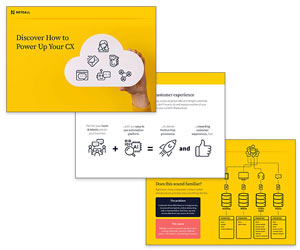Lewis Gallagher at Netcall explores how UK contact centres can empower their agents with the right tools, data, and technology to deliver exceptional, emotionally intelligent customer experiences in an increasingly automated world.
Over the last decade, there has been a significant shift in the role that customer service agents play within the contact centre.
Long gone are the days when you’d call up the bank and speak to an agent for something transactional like finding out your account balance.
A lot of these processes have since been replaced by the rise of automation and applications, supported by AI-driven chatbots that allow customers to self-serve. But that doesn’t mean that these agents have disappeared from the contact centre.
Instead, they have migrated from providing transactional to emotional support for customers – dealing with higher complexity requests whilst allowing technology to take care of the repetitive, and often monotonous, tasks to focus on more engaging and therefore more rewarding areas of the business such as customer care.
Whilst placing more information and control in the hands of customers is certainly positive, the same sense of empowerment must be delivered to customer service agents, to keep up with increasingly complex needs and requests coming into the contact centre.
Thanks to advances in self-serve tools available today, by the time the customer reaches an agent on the phone they are often extremely well-informed.
In many cases, the agent is left to scrabble around and pull from a mass of disjointed and uncontextualised data in order to get the full picture, all whilst dealing with a potentially highly emotional customer on the end of the line.
With so much focus on empowering the customer, agents are at risk of getting left behind in today’s tech-driven world. Left unaddressed, despite the investment in self-serve technologies to support the customer, this will have an extremely damaging impact.
Ultimately, whilst technology certainly has a place in relieving strain on the contact centre and providing customers with the speed and convenience they require, it is no replacement for the personal interaction that can only be delivered by a human agent.
Especially in today’s tough economic climate, which has seen a rise in emotionally charged customers seeking advice from businesses on repayment plans and other financial support.
To provide the proactive and emotional customer support required today, contact centres must have the right supportive processes in place to join up data sources and make sense of it, to empower their agents.
How Well Do You Really Know Your Customers?
When it comes to providing optimal service, knowledge is power. That means really getting to know and understand your customers.
Unfortunately, whilst certainly having a place in driving greater efficiency in customer journeys, canned self-service tools which offer pre-written options and responses can sometimes limit your business’s ability to do just this – ultimately impacting CX.
It is important to recognise the strengths and weaknesses of technology when it comes to interacting with customers and accepting that sometimes a personalised approach is needed in the initial stages of contact to truly understand the reason for contact.
That doesn’t mean steering away from automated responses altogether. It means that rather than being met with limited options when calling your organisation (which might not fit the customer’s needs) the questions are more open – for example, “In your own words, please tell us why you are contacting us”.
Organisations should be letting customers express what matters to them, automated tools can then triage the call to the correct area and escalate to a human with the required context.
AI and chatbots can be a great option for handling routine and repetitive enquiries, leaving human agents to focus on more complex issues.
However, to be successful, they must be underpinned by systems that allow agents to oversee interactions and step in when necessary to provide a personalised touch.
Avoid Empathy-Washing
For those brands that fail to truly understand and know their customers – many can fall into the trap of empathy-washing – presenting themselves as empathetic or compassionate to the customer’s situation without delivering on any real action or resolution.
To avoid this, agents need to be served with the right context and technology to deliver practical solutions, avoiding the need for additional follow-up contact or worse, customer attrition.
Issues surrounding the accessibility and management of data, however, often act as a barrier to achieving this. Disjointed data sets result in disjointed customer journeys.
Such an experience can not only be unsuccessful in reaching a positive outcome, but it can also be time-consuming to manage – leading to greater dissatisfaction all around.
CX platforms developed using low-code, however, can support this by building an end-to-end data flow, that connects throughout the organisation, pre-customer contact and beyond.
Unfortunately, siloed solutions, even if they are considered ‘best of breed’ and tailored towards a specific function, struggle to deliver this without a lot of integration rework.
It is the investment in this kind of ‘rework’ that can put businesses off of transformation projects, therefore a solution that can be easily implemented, and working alongside existing and legacy systems can be critical in driving customer experience forward into the digital age.
Keeping Up With Change
Not only can low-code driven solutions be easily implemented within the contact centre but their flexible nature provides the agility needed to keep pace with changing customer and operational needs.
This allows organisations to not only retain existing customers through optimised CX, but also open up new markets and opportunities by significantly improving time to value.
Tools that empower businesses to adapt can also provide the resilience needed to navigate changing economic, regulatory and compliance factors that may lie on the horizon by reducing the need for agents to find their own workarounds and the shadow IT that this creates.
This reduces the risk to businesses and their governance, as well as bringing down unnecessary and often unaccounted-for costs.
Only when armed with the right tools, technologies and underlying systems can organisations and their customer engagement teams navigate these expectations and respond with an effective resolution.
Once you get this right, it can have a positive knock-on effect, driving down workload volume and reducing complexity whilst boosting productivity, and ultimately facilitating the emotional support customers require.
This blog post has been re-published by kind permission of Netcall – View the Original Article
For more information about Netcall - visit the Netcall Website
Call Centre Helper is not responsible for the content of these guest blog posts. The opinions expressed in this article are those of the author, and do not necessarily reflect those of Call Centre Helper.
Author: Netcall
Reviewed by: Megan Jones
Published On: 3rd Feb 2025 - Last modified: 5th Feb 2025
Read more about - Guest Blogs, Netcall






 Netcall is trusted by organisations worldwide, with 9 out of 10 customers ready to recommend us. With Liberty Converse CX, you can streamline operations, enhance customer engagement, and achieve real, measurable results.
Netcall is trusted by organisations worldwide, with 9 out of 10 customers ready to recommend us. With Liberty Converse CX, you can streamline operations, enhance customer engagement, and achieve real, measurable results. 









